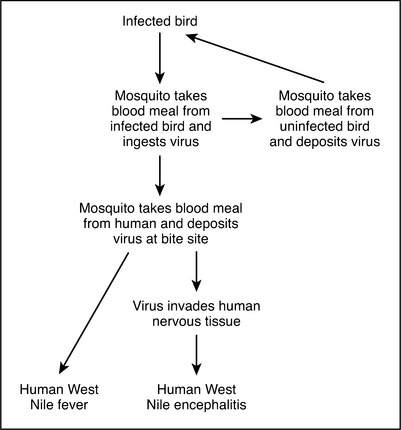WEST NILE VIRUS INFECTION
West Nile virus (WNV) infection is more widespread throughout North America than any of the other equine encephalitides. WNV was originally identified in Europe, Africa (Uganda), the Middle East, and western Asia. In 1999 the first case of WNV infection was reported in the United States. How it got to North America is unknown.
TRANSMISSION
Migratory birds play an important role in the spread of the virus. Common sparrows are resistant to the effects of WNV and are therefore considered natural reservoirs for the virus. Crows and blue jays are severely affected by the virus, and the presence of dead crows or blue jays may indicate the presence of WNV in an area. WNV is spread by the bite of an infected mosquito (Figure 51). Horses and humans are infected when a mosquito takes a meal from an infected bird and subsequently bites a horse or human. Horses, humans, and other mammals do not develop a level of virus in the blood that is significant enough to make them a source of infection to other animals via a mosquito bite; they are, therefore, considered dead-end hosts.
In humans there have been rare cases of transmission of WNV through organ transplants, blood transfusions, breast feeding, and through the placenta during pregnancy.
WEST NILE VIRUS INFECTION IN HORSES
Not all animals showing clinical signs of encephalitis are infected with WNV. Other diseases associated with encephalitis include rabies, botulism, and eastern and western equine encephalitis.
Stay updated, free articles. Join our Telegram channel

Full access? Get Clinical Tree



